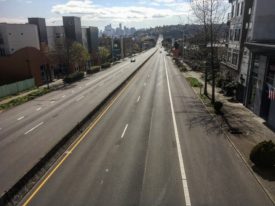More like this please. It’s pretty well known that official measures of poverty are inaccurate relics. Among other problems, they do things like this:
For the federal government, the concept of poverty is simple. If a typical family of four earns less than $21,100 a year, they’re poor. If a single working woman makes less than $10,787, she’s in poverty. It doesn’t matter whether these people live in Omaha, Neb., where the average apartment rents for $600 a month, or in New York City, where a similar apartment costs $1,600 a month.
Conventional poverty measurements systematically discriminate against places with a high cost of living—and that usually means cities. So it’s encouraging to see New York seize the initiative to develop a more realistic assessment.
As the Christian Science Monitor reports:
New York’s new poverty measurement takes into account rent, utility fees, food costs, clothing costs, and also includes other benefits for low-income families and individuals like Section 8 housing vouchers and food stamps. The change is expected to boost the city’s poverty rate from 19 percent to 23 percent. That would mean 30,000 more people would qualify for assistance programs.
That’s exactly as it should be. We need a more accurate accounting of the true costs (as well as the available benefits) of living in cities.
In truth, geographic disparity is just one of many serious flaws with the official poverty measurements. But that said, the geographic disparity is a very big problem, especially for the urban poor because the official poverty line determines eligibility for all sorts of programs and benefits.
When you think about it, there are geographic disparities in all sorts of measurements that rely on standard national figures. For example, the standard Medicaid reimbursement rate may be reasonable for midsize cities, but they are much too low for the medical costs in big coastal cities. So Medicaid coverage is apparently getting scarce in some urban areas—another blow for lower-income people.
Even higher income folks may be getting the short end of the stick, as in the housing market. In many metro areas, a “jumbo” mortgage is required to buy a median-price house. So some urban buyers may not have access to the better financing terms available with regular mortgages.
Not surprisingly, however, it’s pretty difficult to fix these disparities. Deviating from a single national standard to adjust for local cost of living might be a political scrum as local interests jostle for scarce resources. For example, changing the poverty line—which is pretty much universally acknowledged to be badly flawed—has proven fruitless so far:
For many years, poverty experts have argued that the food-based measure doesn’t accurately portray reality. Once in the ’70s and again in 1995, they convinced Congress to take up the issue and try to revise the federal guidelines. Both times Congress requested reports but essentially ignored their recommendations.
But there may yet be hope, with an assist from an urban Cascadian policymaker:
At the federal level, a bill moving through Congress aims to update the federal measurement by including the sharp geographical differences in expenses. Written by Rep. Jim McDermott (D) of Washington, it has already garnered support from Sen. Barack Obama during his presidential campaign.







